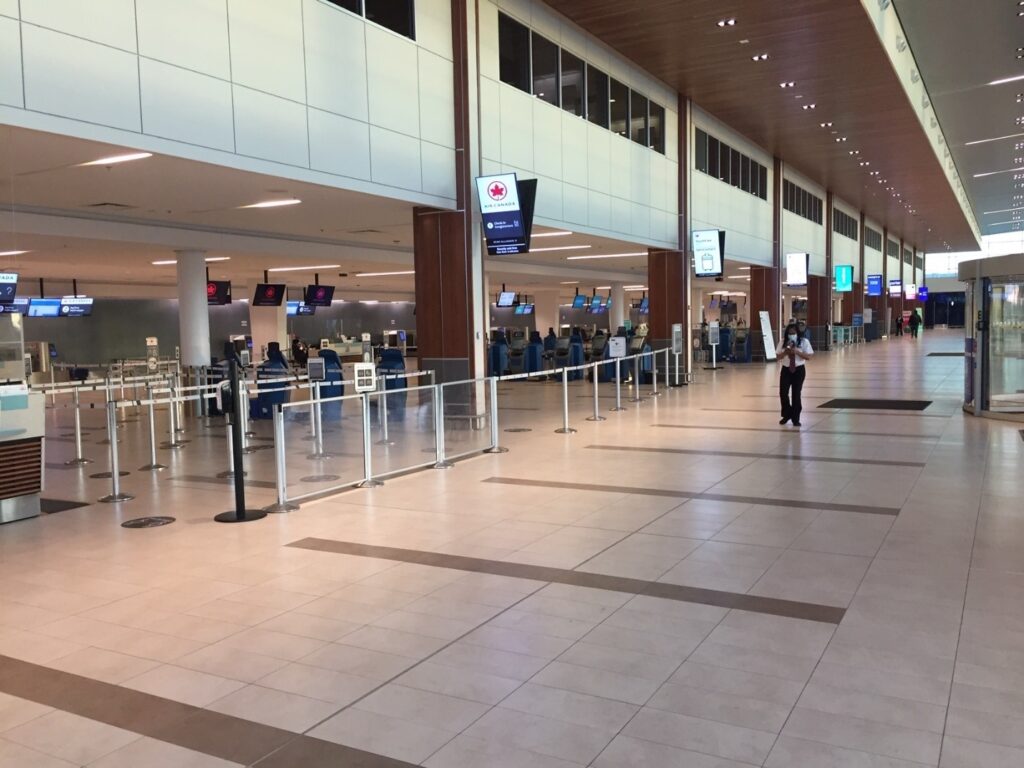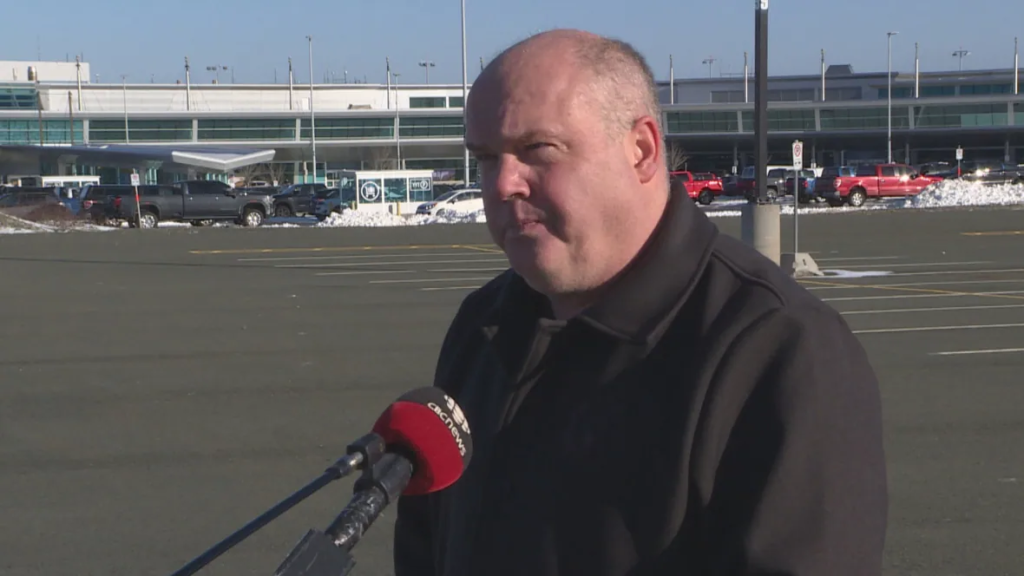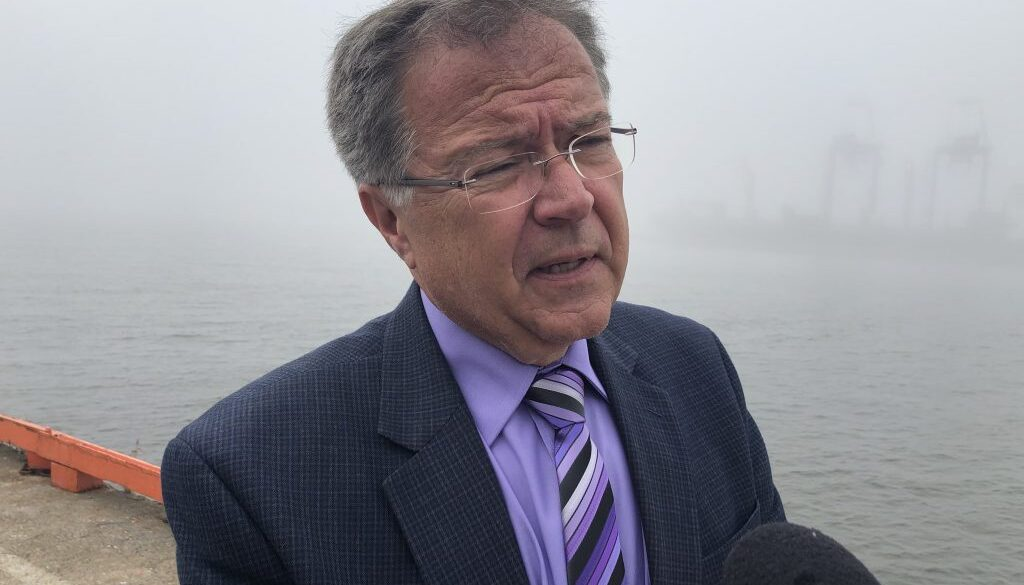Welcome to the February 2022 installment of Atlantic Transport News!
Here’s a look at what you’ll find in this edition:
- VIA holds “Market Day” for Long-Haul equipment suppliers
- Halifax Airport traffic “stalled” in 2021
- St. John’s airport paralyzed by firefighters dispute
- CAT to set sail again in 2022
- Foot-dragging on Campobello ferry “outrageous” says NB’s newest Senator
- Remembering two Atlantic transportation leaders
VIA HOLDS “MARKET DAY” FOR LONG-HAUL EQUIPMENT SUPPLIERS

VIA Rail Canada has confirmed it is preparing a business case for the renewal of its aging long-haul locomotives and cars – some of which are more than 70 years old. The Crown corporation hosted a virtual “Market-Day” event with suppliers on January 20 to discuss the project and seek their input on various elements including schedule, budget, procurement and delivery timeline. Those discussions will inform the submission to the federal government, which will ultimately have to approve the necessary funding. The latest version of VIA’s 5-year Corporate Plan, which has just been released to the public, is rather pessimistic on how long the process will take, suggesting that delivery of new equipment may well be 10-15 years in the future.
VIA is being somewhat coy about which potential suppliers might be involved. The invitation posted in December on the MERX public tendering website was extended to “all tier 1 original equipment manufacturers of intercity and long-distance rail cars and locomotives”, adding that the day would be dedicated to both informing the market about the fleet renewal opportunity and addressing the context of the Government of Canada’s 2022-2023 Budget.
A spokesperson in the office of CEO Cynthia Garneau did say the participating suppliers at the market day came from “across the world”, but was not in a position to say how many there actually were. However, it’s a safe bet that Siemens Mobility will be among the contenders to at the very least build new locomotives. Siemens is already supplying 32 bi-directional trainsets to replace VIA’s entire corridor fleet by the end of 2024. The first of these is currently undergoing testing in real-life winter conditions on the Alexandria Sub between Ottawa and Coteau QC. The first revenue service is set to take place later this year. The testing is reportedly going well.
Each of the new VIA trains includes a Siemens Charger locomotive, the current state-of-the-art in low-emission diesel-electric traction. The company also builds a long-distance version of the Charger. As of February 8, Amtrak now has a total of 125 of the so-called ALC42 units on the way, having just exercised an option to add 50 more to its current production order.
The ALC42 boasts a 1000-kilowatt head-end power capability for car heating and hotel services, compared to 600 kilowatts on the ones in VIA’s current order, as well as 20% more fuel capacity for longer range. Amtrak has had the first two units for testing over the past six months, and they’ve just been placed in revenue service on the Chicago-Seattle Empire Builder.
Meanwhile, the union representing many of VIA’s employees wants Ottawa to pour “significant dollars” into the corporation’s long-haul fleet renewal, and it views the Halifax-Montreal Ocean as a priority. Unifor spokesperson Scott Doherty told the Campbellton Tribune that upgrading passenger rail transportation is a key factor across the country. He said that the Trudeau Government needs to follow the lead of the Biden White House, which as just committed to the largest public investment in Amtrak’s entire history.
“It can’t just be fast rail service from Toronto to Ottawa or Montreal to Windsor,” he said. “That can’t be the only place where investments get made.” He added that rail travel is “a green, environmentally acknowledged form of transportation, and it’s got to be affordable.”
-Ted Bartlett
HALIFAX AIRPORT TRAFFIC “STALLED” IN 2021

2021 was another turbulent year for air traffic through Atlantic Canada’s busiest airport. For the second year in a row, passenger activity at Halifax Stanfield airport was down roughly 75 per cent compared to pre-pandemic levels. 1.1 million passengers travelled through the airport in 2021, compared to 4.2 million passengers in 2019. Domestic travel reached roughly a third of 2019 levels in 2021, but US and international travel was nearly non-existant due ongoing international travel restrictions, and limited direct international flights to and from Halifax. This has resulted in significant financial losses for the Halifax International Airport Authority (HIAA).
“The past two years have been the most challenging years in Halifax Stanfield’s history,” said Joyce Carter, President and CEO, HIAA, in a news release. “We anticipate that it will take several more years for the airport to fully recover from the effects of COVID-19, and the recovery path will have many ups and downs along the way.”
After a slow start to the year, travel began to pick up through the late summer, as travel restrictions eased, and increasing vaccination rates helped raise traveller confidence. The return of air service created a sense of optimism, and more passengers were served during the month of August than the months of January to July combined. However, much of this progress was blunted by the pre-Christmas spike in COVID-19 cases due to the Omicron variant and restored caution against non-essential travel.
The overall decrease in passenger traffic during the pandemic has had a significant financial impact on the HIAA, airlines, and other businesses connected to the airport, including food, beverage, and retail concessions. According to a news release from the HIAA, approximately 45 per cent of concessions in the air terminal building remain closed because of the low passenger volumes, while others have reopened on limited hours due to less frequent flight activity and ongoing labour shortages.
Other airports throughout the region reported similar news, while also looking ahead with some cautious optimism. St. John’s International, Atlantic Canada’s second largest in terms of passenger numbers, has yet to release statistics for 2021, but Greater Moncton’s Roméo LeBlanc Airport – number three in the region – confirmed that its passenger arrivals and departures showed only slight improvement from the previous year.
In a media release on February 7, the airport authority acknowledged the uncertainty hanging over YQM in 2021. Even though it was the only New Brunswick airport handling passengers during the first half of the year, the facility saw only 10% of normal activity during that period.
A stronger recovery over the summer months meant that YQM was able to close the year at 177,040 passengers – a slight improvement over the prior year’s total of 173,404. Still, this remains down 74% compared to pre-COVID 2019 activity levels of 674,406 passengers.
-Tim Hayman, with files from Ted Bartlett
ST. JOHN’S AIRPORT PARALYZED BY FIREFIGHTERS DISPUTE

It was neither a consequence of COVID nor winter weather, but for a four-day period in mid-January the region’s second busiest airport was brought to an effective standstill. The issue was a long-festering labour dispute with firefighters at St. John’s International Airport.
The first flight cancellations came on January 17, after two-thirds of fire hall staff went on leave due to concerns about what they claimed was a toxic workplace. Chris Bussey, the regional vice-president of the Union of Canadian Transportation Employees, told CBC News that firefighters were complaining about harassment and bullying after bringing health and safety concerns to their employer. Mr. Bussey said his members had reached a point where they had nowhere else to turn.
He said six out of nine firefighters asked their family doctors to take them out of the workplace to “protect their psychological health and safety”, leaving just three to respond to potential emergencies. He noted that airport firefighters require specialized training under international aviation regulations, which means staff can’t be supplemented by the St. John’s Regional Fire Department. At that point there was only one firefighter with one crash truck serving the airport – a service level sufficient for small planes, like a Dash 8, but not for larger aircraft.
A spokesperson for the St. John’s International Airport Authority confirmed operations had been affected by staffing levels, but declined to specifically address the issues with the media. By next day YYT was essentially at a complete standstill, except for medevac and cargo flights. For obvious geographic reasons, St. John’s is arguably more dependent on its airport than any other Canadian city of comparable size. Federal Labour Minister Seamus O’Regan, who represents one of the city ridings, said he was working with Transport Minister Omar Alghabra to try to find a resolution.
It took several days of apparently-intense negotiation with the aid of senior federal mediator Barney Dobbin, during which time a limited number of flights were able to operate under an interim arrangement, while others were diverted to Gander. A cryptic media release from the airport authority late on the fourth day of the disruption announced that the matter had been resolved and normal operations could now be resumed. Without giving any details, the statement said only that the issues had been addressed, adding that “we are committed to work with the union to ensure that this does not reoccur.”
It was several days more before flight schedules had fully returned to their COVID-reduced normal levels.
-Ted Bartlett
CAT TO SET SAIL FROM YARMOUTH AGAIN IN 2022

After yet another year out of service due to ongoing pandemic related travel restrictions, Bay Ferries is finally anticipating a return to service for the much maligned CAT ferry between Yarmouth and its new terminus of Bar Harbor, Maine. The company has announced a service resumption date of May 19, beginning with four crossings a week – Thursday, Friday, Saturday, and Monday. The service will expand to daily crossings from June 23 to September 11, dropping to six days a week until October 10, when sailings will end for the season.
The ferry will depart from Yarmouth at 9:30am, and depart for its return trip from Bar Harbor at 3:00pm. The shorter schedule facilitated by the new US terminus, at 3 ½ hours, makes this tighter turnaround possible, and facilitates better scheduled times in each direction. Tickets for the season can be booked via the Bay Ferries website. Adult fares are $115 one-way for walk-on passengers, or $210 for a round trip ticket, with discounted rates for seniors and youths; children under 6 years of age are free. Vehicle fares begin at $199 for a standard car, with increasing rates for larger vehicles and trailers, added to the initial passenger fare. Fares for smaller vehicles are lower, beginning at $20 for a bicycle. A special “Atlantic Adventure” package is also available, which offers discounted rates for walk-on round-trip travel where both crossings are completed within 72 hours. Canadian passengers may be disappointed to realize that all fares are presented in US funds, which means that the ferry pricing will be much steeper for Canadians depending on the exchange rates.
As with any travel in this time, scheduling and the actual return to service remain contingent on the public health situation, and any cross-border travel restrictions that may exist or evolve as the year unfolds. Full refunds are available on any trips cancelled at least 24 hours before departure.
FOOT-DRAGGING ON CAMPOBELLO FERRY ISSUE “OUTRAGEOUS”, SAYS NEW BRUNSWICK’S NEWEST SENATOR

The normally-seasonal ferry serving Campobello Island has received yet another extension – this time until May. Scheduled to tie up for the season at the end of December, the tug-and-barge operation linking Campobello to the New Brunswick mainland via Deer Island is continuing to run four days a week, weather permitting and at the discretion of the operator. The Department of Transportation and Infrastructure foots the bill, which is about $60,000 a month.
Reaction among the island’s 800 permanent residents was generally positive, even though it’s widely recognized that the current ferry is poorly suited to the task at hand for a variety of reasons, not the least of which is that it was never designed for operation under winter conditions. Advocates are seeking a permanent, year-round solution with a more suitable vessel that ensures residents won’t have to travel through the US to access services in mainland New Brunswick. The Province has balked at the idea, maintaining that the island has a bridge to the state of Maine, and the federal government has so far refused to come to the table – even though an ACOA-funded study identified clear economic benefits from a year-round ferry, both to the island and the province as a whole.
It’s a situation that the province’s newest member of the Red Chamber in Ottawa finds “outrageous”. In a wide-ranging virtual discussion with a delegation from Transport Action Atlantic, Senator Jim Quinn said it’s a matter he’s prepared to pursue, and that a situation like this just wouldn’t happen in a part of Canada considered more politically important. He’s in a good position to know, having served many years as a senior federal public servant before becoming CEO of Port Saint John.
Senator Quinn is a member of the non-partisan Canadian Senators Group. He’s supportive of many of the issues on TAA’s sustainable transportation agenda.
-Ted Bartlett
REMEMBERING TWO ATLANTIC TRANSPORTATION LEADERS
Two prominent industry personalities from the late 20th Century, have passed away in recent weeks. Harry Steele and Rupert Tingley were both in their 90s. Mr. Steele, who died in St. John’s on January 28, has been widely described as a business titan. He achieved initial fame at Eastern Provincial Airways –“the little airline that could” – and served as chairman of Canadian Airlines International for over a decade. Mr. Tingley passed away in Moncton on February 2. He was a railroader whose career track led him down to the sea, whose name was synonymous with ferry service in Atlantic Canada for 15 years.
Lieutenant Commander Harold R. Steele was a career navy man, whose final military posting placed him in command of CFS Gander, not far from his birthplace in the remote Newfoundland outport of Musgrave Harbour. While there, he and his business-savvy wife Catherine acquired a bankrupt hotel named, perhaps somewhat inappropriately, the Albatross. By the time he left the forces in 1974 the hotel was doing well, and he accepted an offer as a vice-president with Eastern Provincial Airways, then part of the Crosbie group of companies. He lasted less than a year in that job – but long enough to recognize the struggling airline as an opportunity.

The Steeles mortgaged their home and the hotel to augment the money they’d earned in some astute stock market trades, and by 1978 had acquired control of EPA. He turned it into a money maker, built a reputation for customer service and satisfaction, played politics and overcame the Transport Canada bureaucracy to defeat the much-larger CP Air in a struggle to win the lucrative Halifax-Toronto route, and took on striking pilots in a bitter and very public dispute. (During the labour troubles, Harry Steele was widely quoted as referring to the strikers as “overdressed, overpaid, oversexed bus drivers” – something he always maintained he never said – but the legend persists to this day.)
He also lost some friends in Newfoundland, and Gander in particular, by moving the airline’s operational hub to Halifax. It was a sound economic decision in light of the new Toronto routes, and no doubt facilitated the sale of EPA to CP Air at a substantial profit in 1984.
Mr. Steele was soon named to the board of CP Air, and eventually became non-executive chairman of Canadian Airlines International. But his aspirations to lead the new carrier into an enduring national and world-wide presence came to naught. Battered by the turbulent skies of the 1990s, Canadian ceased to exist with the arrival of the new millennium, and was acquired and merged into Air Canada. In later years, Harry Steele’s business focus was in broadcasting, but it was said he always refused on principle to fly Air Canada. At the time of his death, the Albatross Hotel was still in the family.

Rupert J. Tingley, a native of Petitcodiac NB, also served in Canada’s military as a member of the RCAF. On release from the service he attended the University of New Brunswick, earned his engineering degree, and like many young New Brunswickers of the postwar era found employment with Canadian National Railways in 1952. His assignments around Atlantic Canada involved him in a number of marine-related projects, including building a dock for the new Newfoundland ferry William Carson at North Sydney.
Returning to the region after postings in Montreal and London Ontario, he became interested in a new and emerging technology – containerization. It was still early days, but he became an avid student, as was soon assigned to establish the railway’s container development branch. This led to a promotion as regional marketing manager, and then came a move that plunged him head-long into the ferry business as area manager for Newfoundland. To his everlasting embarrassment, he became deathly seasick on his first voyage from Argentia to North Sydney.
A few years later CN management and Transport Canada agreed to consolidate the various railway-run marine services into a single operating entity. The unwieldy-named East Coast Marine and Ferry Service was launched in 1973, with headquarters in Moncton just down the street from CN’s regional HQ building. Rupert Tingley was appointed general manager of the division, which was renamed CN Marine and given the now-familiar “wavy-navy” logo in 1976.
He oversaw the development of the region’s first custom superferry design that resulted in the 1980s construction of MV Caribou and MV Smallwood, and on creation of a separate Crown corporation to manage federally-supported ferry services in the region, he was logical choice to lead it. Following passage of enabling legislation in Parliament, Marine Atlantic was officially inaugurated on September 3, 1986, with Rupert Tingley as its first president and CEO.
Soon after his 1988 retirement, maybe remembering the long-ago encounter with mal de mer, or perhaps correctly anticipating that the immense concrete Confederation Bridge would replace the PEI ferries within a decade, he purchased controlling interest in two companies specializing in the trucking of cement.
-Ted Bartlett





